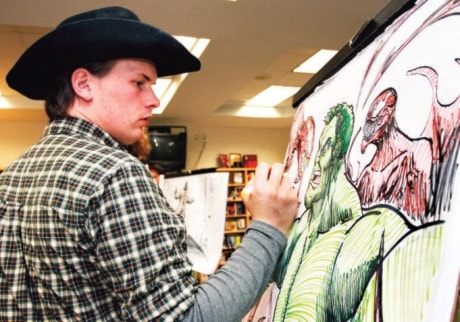Most comic book fans want to know how a story makes its way from an idea to a $3 purchase at the 7-Eleven. If you were at St. Augustine School May 25, you would have been able to satiate your curiosity.
St. Augustine students had the opportunity to hear how the industry works from Jay Bardyla, owner of Happy Harbor Comics in Edmonton. The owner has hosted these information sessions free to schools to promote his business as well as “inspire and motivate kids” to be creative.
Three artists drew well-known comic book characters such as Superman, Batman and others while Bardyla walked students through the stages of making a 20-page comic book.
He said two companies, DC Comics and Marvel, produce approximately 80 per cent of the comics in the market.
It starts with an editor.
It’s the editor’s job to bring artists and writers together before creating a book; it is also important for them to be able to work together as a story may not sell as well.
“Your end product is not going to be as good as it possibly can if your team working together isn’t all on the same page,” explained Bardyla.
Once the talent is on board, the first stage of the comic book goes to the writer. This person creates the story based on a specific set of rules of the characters. Bardyla used Superman as an example and said it would be much faster for the Man of Steel to fly around the work and chop off the heads of the villains. “That would eliminate crime awfully fast, but there’s a very key rule to Superman, and Superman does not kill.”
Despite being in an unrealistic world, he suggested aspiring writers should invest time in the characters they create. This enables readers to identify with the protagonist, which is what keeps people involved in a story.
Research is an important facet to a story, as readers do not take information at face value compared to the days of Stan Lee — who has created hundreds of characters, including Iron Man, Spider-Man and the Hulk.
“The audience has changed and evolved,” he said.
Once the writer has the information they need, they can begin to write, keeping in mind it must fit in a 20-page-book. Once complete, the editor reviews the story for errors. “It takes anywhere from three and five days to produce a story.”
Phase two is a three-part process involving a penciller, inker and a colourist. These artists put the story into pictures.
The penciller usually works as quickly as possible as they are paid per page. Their role is not to draw the perfect picture, but to get the story on paper.
“If they stop to erase, they stop being creative. It’s an important rule to keep moving forward,” stated Bardyla.
Their challenge is to make each page different from previous ones. A page typically takes eight hours to complete and is again reviewed by the editor.
The inker then takes the page and outlines the artwork; this is when corrections to the original drawings are made. Inking will have variations to how thick it is drawn on the page. This gives dimension to the comic book. They will also add shadows to show where light comes from and to help create a realistic environment. “The page is a lot more exciting with ink. It’s adding to the reality of what we’re looking at.”
Again the editor, who plays a part in every step of the process, reviews the inking. The days of liquid paper and Scotch tape to fix errors are just about over, said Bardyla .The majority of work, except for the penciling, is done on a computer. Once penciling is complete, the artists will scan it into a computer for editing.
The colourist starts the next phase.
“Colour has probably seen the greatest evolution in technology and performance since comic books were first being made,” he explained.
Until about 1950, Bardyla said comic books were made using four colours: cyan, magenta, yellow, and key (black). Tiny dots were used to print the colours and when a printer wanted to show the colour green, then blue and yellow were printed. “Today pretty much all comics are coloured digitally.”
He used Adobe Photoshop as an example and said it gives artists access to more than two million different colours. Colouring is a two-part process with the first step called flatting, which is painting in specific areas on the page, usually a 45-minute process. The second part is to transition those colours from dark to light to make the artwork more realistic.
The last step is for the letterer. Usually a two to three day process, their job is to find spaces in the artwork to be able to write and fill in with storyline and dialogue.
For a company such as DC Comics, pencillers are used in Argentina or the Philippines, colourists in Canada, and writers in England. The entire process is approximately two months of man-hours for one comic book.
Bardyla has not seen too much of a loss of business in the industry either, as he has many customers who prefer to have a comic book in their hands as opposed to downloading a digital copy. “Typically if they like something, they want to own it.”
Bardyla said he has become busy enough between his regular work and presentations that they only host it once a week now. The artists at the school presented their work to St. Augustine as a gift.
By Jeffrey Heyden-Kaye
